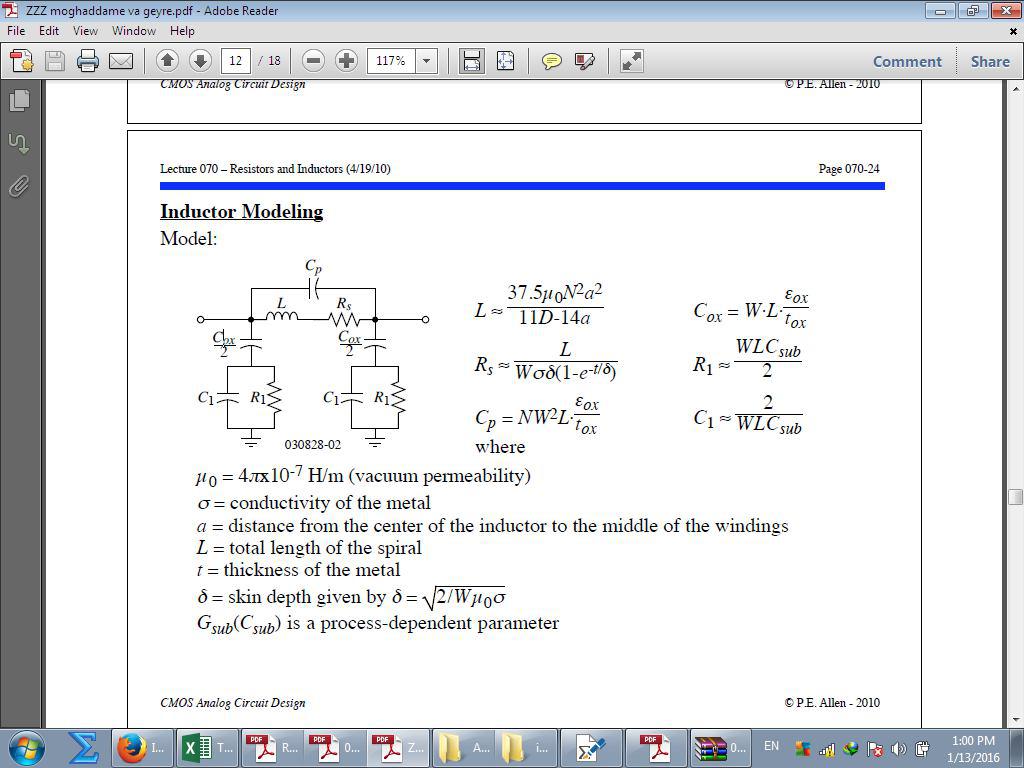How to calculate parasitic resistance and capacitance of an inductor theoretically
Any help and insights would be greatly appreciated.
Obviously there's the DC resistance which you measure with an ohmmeter. This is likely to be very small, because an inductor operating at 40 GHz is likely to have few loops of wire.
Likewise capacitance between neighboring loops is liable to be very small.
Skin effect plays a part at high frequencies.
One wavelength at 40GHz is 1/3 inch. This approaches a point where component size can influence performance, although I don't know exactly how, nor what formula to apply.
Thank you for your reply. Yes, I know how to measure the DC resistance and all, and I've got estimations of all parasitic elements, but I'm looking for an exact calculational base for my measurements.
I've come across a model whose image I've uploaded, and I've found all the parameters in it except for Csub. I know it can be calculated by Csub=Ca*length*width + Csw*2*length, but the substrate capacitance per unit area (Ca) and the sidewall substrate capacitance per unit length (Csw) are still unknown to me. Does anybody know their values?

Well, it depends on the shape of the inductor that you have...
What I have found is the typical model for the inductor with series resistance, capacitance and the inductance for an air core inductor.

Not trivial to estimate this. We don't even have that one simple ground node as depicted in the equivalent circuit model.
Angelo Scuderi et al provide some useful equations for equivalent circuit modelling in "Integrated Inductors and Transformers" (CRC Press).
In this book, you will find : Rsub*Csub = epsr_sub * rho_sub (Pfost, Rein, Holztwarth 1996). However, when I tried to apply that for real world SiGe inductors with non-homogeneous substrate doping (EPI layer) that equation didn't work well.
My approach is to extract the equivalent circuit model parameters from EM simulated (or measured) inductor data.
http://muehlhaus.com/products/equiva...rfic-inductors
Thank you very much, volker@muehlhaus. The information was helpful, though I've found a seemingly more complete model with all the values in the book "RF Power Amplifiers" by Dr.M. Kazimierczuk. The results it yields are close enough to my estimations, so I guess it can help me work something out. And I have done EM simulations in HFSS, but because I had to look for a computational model, they were not sufficient for me. I just have to check their consistence with my calculations now.
I still have one more question left: When printing DC operating point for inductors in Spectre, three values of Csub are shown. Why are they three, and what is each of them?
I don't know your netlist, but for a center tapped inductor I would expect threee substrate branches in the model, so that we have three Csub elements. Two of them would be identical if the inductor is symmetric.

Image is from:
http://muehlhaus.com/wp-content/uplo...1/modelfit.png
resistance parasitic calculate 相关文章:
- Adding ports to know resistance at some point in 2-patch antenna
- Microstrip Negative Resistance Oscillator Nyquist plot Encirclement issues
- What is the gate resistance of the LDMOS?
- Calculating Resistance/Capacitance values from measured/simulated S-parameters
- MOSFET Resistance rout and Rds (ON)
- Negative resistance oscillators that designed wrong
